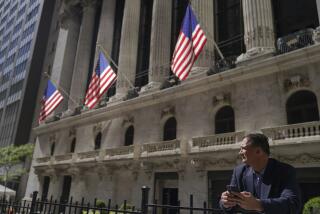NYSE Signals New Stand on Market Halts
- Share via
New York Stock Exchange Chairman Richard Grasso on Friday suggested the Big Board may be ready to change the much-criticized circuit-breaker rules that halted trading last week.
U.S. markets shut down Oct. 27 after the Dow Jones industrial average fell 350 points and again when it declined 550 points. Securities firms say that scared away investors who might have jumped in to buy.
In discussions with member firms, “the sentiment I’m getting is that 350 and 550 points are too low,” Grasso told a news conference at the Securities Industry Assn.’s annual conference in Boca Raton, Fla.
Grasso, who in the past has resisted loosening the circuit breakers, is the securities industry leader on this issue, and the other U.S. stock markets tend to follow his example. The chairmen of the Pacific and Philadelphia stock exchanges called Friday for a loosening of the triggers and a regular review of those levels.
The current rules, which presumably deter panic-selling by giving investors a breather, halt trading for half an hour when the Dow average falls 350 points and for an hour when it falls 550. In 1987, the year of the stock market crash that prompted the rules, a 550-point drop would have cut 25% from the Dow; today, 550 points represents a 7.3% decline.
Nasdaq Stock Market officials have previously suggested that circuit breakers, which halt trading on all U.S. markets, be changed to a percentage basis. Many Wall Street executives have complained that the circuit breakers unnecessarily interfered with trading Oct. 27.
A Nasdaq spokesman declined to comment Friday.
Richard Lindsey, the market regulation director for the Securities and Exchange Commission, told the Florida conference that he opposes a switch to percentages, believing they would be difficult for investors to quickly grasp.
The SEC is studying possible changes in circuit-breaker rules and promised to report its findings to Sen. Phil Gramm (R-Texas), who heads the Senate Banking subcommittee on securities, by January. The Treasury Department and the Federal Reserve Board are conducting similar studies.
More to Read
Inside the business of entertainment
The Wide Shot brings you news, analysis and insights on everything from streaming wars to production — and what it all means for the future.
You may occasionally receive promotional content from the Los Angeles Times.










